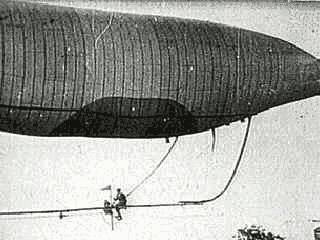Morrel's Ariel
Today, we watch a heroic failure. The University of Houston's College of Engineering presents this series about the machines that make our civilization run, and the people whose ingenuity created them.
Other Engines episodes have linked California gold to the dream of flight. Most early American dirigible attempts hovered around California like moths about a flame. The wildest of them all was made in a vacant lot near Berkeley High School.
It was 1908, only four years after America's first successful dirigible ascents were made just a few miles away. John Morrel, an inventor from Chicago, wanted to set up dirigible service between San Francisco and the East. The idea wasn't new. It was an obsession that'd destroyed inventors for 60 years.
Here's one of Morrel's pamphlets. It shows a huge pencil-straight powered balloon a quarter-mile long. It's driven by eight 400 HP engines. It promises to carry 500 passengers and 40 tons of mail across America in just one day.
Morrel's first balloon had broken away from its moorings with no one in it and drifted twenty miles. Now he readies his second airship. It's only a third as long as the one promised in the pamphlet. It's just a step on the way. But its 485-foot length makes it a remarkable beast by any standard.
We find old photos of that flight. The pencil-straight intention of the design is warped in its execution. We see a horrible parody of what it was to have been. The gigantic gas bag looks for all the world like a sand worm from the movie Dune. It twists in the sky at the end of restraining ropes.
Morrel and twenty others board the monster as it writhes on its ropes. An inexperienced ground crew releases the balloon unevenly. It lurches 300 feet into the air, and the crowds cheer, but one end rises faster than the other. Gas rushes up through the unpartitioned bag and bursts it open. Morrel's dream flutters to earth and badly injures nine people.
By now Zeppelin had learned to make a really good dirigible. Now you could easily get to California on a train. And, in any case, her gold fields were no longer productive. The game was already over when Morrel built his quixotic machine.
Morrel seemed unruffled by failure. He was ready to build his quarter-mile-long model. But his backers had had enough. They deserted him, and he faded into oblivion.
And we're left to wonder: how many wacky experiments did it take to produce flight, or the computer, or space travel? The answer is, "Far more than we'd wish." I wonder: how many grand failed experiments have you watched in your life? The answer is: "Not enough! Not enough to change tomorrow the way our great- grandfathers changed their world."
I'm John Lienhard, at the University of Houston, where we're interested in the way inventive minds work.
(Theme music)
Kurtz, G.F., 'Navigating the Upper Strata' and the Quest for Dirigibility. California History, Vol. LVIII, No. 4, Winter 1978/9, pp. 334-347.

clipcart
An unidentified photo of an early dirigible -- probably earlier than Morrel's